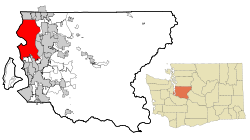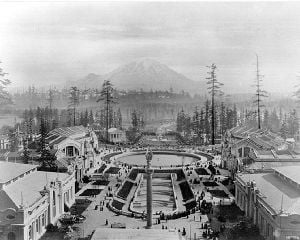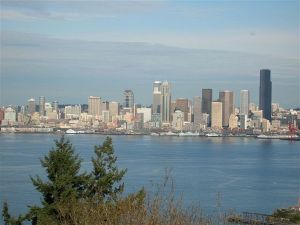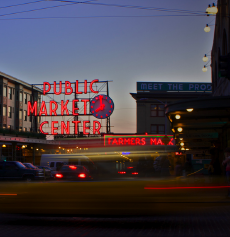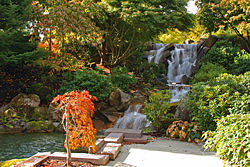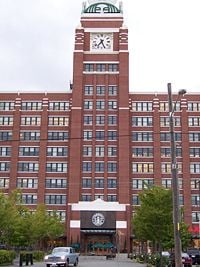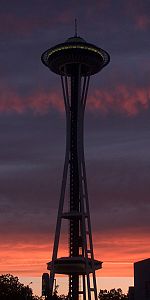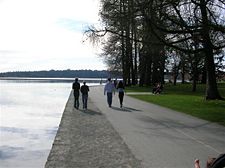Seattle, Washington
| City of Seattle | |
| Nickname: The Emerald City | |
| Location of Seattle in King County and Washington |
|
| Coordinates: {{#invoke:Coordinates|coord}}{{#coordinates:47|36|35|N|122|19|59|W|type:city | |
|---|---|
| name= }} | |
| Country | United States |
| State | Washington |
| County | King |
| Incorporated | December 2, 1869 |
| Government | |
| - Type | Mayor–council |
| - Mayor | Greg Nickels (D) |
| Area | |
| - City | 142.5 sq mi (369.2 km²) |
| - Land | 83.87 sq mi (217.2 km²) |
| - Water | 58.67 sq mi (152.0 km²) |
| - Metro | 8,186 sq mi (21,202 km²) |
| Elevation | 0–520 ft (0–158 m) |
| Population (July 1, 2006)[1][2] | |
| - City | 582,174 |
| - Density | 6,901/sq mi (2,665/km²) |
| - Urban | 3,263,497 |
| - Metro | 3,919,624 |
| Time zone | PST (UTC-8) |
| - Summer (DST) | PDT (UTC-7) |
| ZIP codes | 98101, 98102, 98103, 98104, 98105, 98106, 98107, 98108, 98109, 98110, 98111, 98112, 98113, 98114, 98115, 98116, 98117, 98118, 98119, 98125 |
| Area code(s) | 206 |
| FIPS code | 53-63000GR2 |
| GNIS feature ID | 1512650GR3 |
| Website: www.seattle.gov | |
Seattle is a coastal port city and the largest city in the Pacific Northwest region of the United States. It is located in the state of Washington between an arm of the Pacific Ocean called Puget Sound and Lake Washington, about 96 miles (154 km) south of the Canada – United States border in King County, of which it is the county seat. In 2006, the city had an estimated population of 582,174 and an estimated metropolitan area population of approximately 3.2 million.
The land upon which Seattle sits has been inhabited for at least 10,000 years, but European settlement began only in the mid-19th century. First known as "New York-Alki" and "Duwamps," early settler David ("Doc") Swinson Maynard proposed that the main settlement be renamed "Seattle," an anglicized rendition of the name of Sealth, the chief of two local Native American tribes. The friendship formed between the Chief and the original settlers was crucial to the city's formation.
Seattle has been the birthplace of a variety of institutions that have added to its identity - Microsoft, Starbucks, and Grunge music, among others. Its landscape and location play a large part in defining its personality, as does its diverse mix of cultures and religions. Surrounded by mountain ranges and bodies of water, the beauty and freshness of its natural environment has instilled in its people a healthy respect for nature and a strong consciousness of human responsibility to it.
History
The area that is now Seattle has been inhabited since the end of the last glacial period (c. 8,000 B.C.E.—10,000 years ago). When European explorers came to the area in the late 1790s they found the Duwamish tribe, a Salish people.
Settlement and founding

The two-ship Vancouver expedition entered the waters of Puget Sound in 1792. In 1833, the Hudson's Bay Company established Fort Nisqually. In 1841, the Sound was surveyed by Charles Wilkes of the U. S. Exploring Expedition. A settlement was established approximately 75 miles south of what was to become Seattle.
On September 14, 1851, King County's first white settlers arrived at the mouth of the then-winding Duwamish River. This was the Luther and Diana Collins party, which consisted of this husband and wife, their two children, plus Henry Van Asselt, Jacob Mapel (or Maple) and his adult son Samuel. However, they are not considered Seattle’s original founders, as they settled several miles up the river. Their settlements were eventually annexed by the city of Seattle in the early 1900s.[3]
On September 25, 1851, another group of settlers arrived in Elliott Bay. David Denny, John Low, and Leander (Lee) Terry arrived at a point later called Duwamish Head and set up camp. They met and befriended Chief Sealth (Seattle) of the Duwamish tribe. The friendship formed between the Chief and the original settlers was crucial to the city's formation.
These settlers explored the shoreline of Elliott Bay and the Duwamish River looking for the best land on which to settle. Terry Low returned to Oregon at David Denny's request, to tell the rest of the party to "come quickly." The rest of the Denny Party set sail from Portland and landed on Alki during a rainstorm on November 13, 1851. The landing party's first sight of their new homestead was the roofless cabin that David had been unable to complete due to illness.
After spending a winter of frequent rainstorms and high winds on Alki Point, most of the Denny Party moved across Elliott Bay and settled on land where present day Pioneer Square is located and established the village of "Dewamps" or "Duwamps." The only members of the party that did not migrate to the eastern shore of Elliott Bay were Charles Terry and John Low, who remained at the original landing location and established a village they initially called "New York," after Terry's hometown, until April 1853 when they renamed it "Alki," a Chinook word meaning, roughly, by and by or someday.[4]
The villages of New York-Alki and Duwamps would compete for dominance in the area for the next few years, but in time Alki was abandoned and its residents moved across the bay to join the rest of the settlers.
David Swinson ("Doc") Maynard, one of the village's founders, was the primary advocate for renaming the village to "Seattle" after Chief Sealth. Doc Maynard's advocacy bore fruit, because when the first plats for the village were filed on May 23, 1853, it was for the Town of Seattle. In 1855, nominal legal land settlement was established and the city was incorporated in 1865 and again in 1869, after having existed as an unincorporated town from 1867 to 1869.[5]
Major events
Major events in Seattle's history include:
- The Great Seattle Fire of 1889, which destroyed the central business district but took no lives.
- The Anti-Chinese riots of 1885–1886.
- The Klondike gold rush, which made Seattle a major transportation center.
- The Alaska-Yukon-Pacific Exposition of 1909, which is largely responsible for the layout of the University of Washington campus.
- The Seattle General Strike of 1919, the first general strike in the country.
- The 1962 Century 21 Exposition, a World's Fair.
- The 1990 Goodwill Games.
- The APEC leaders conference in 1993.
- The World Trade Organization Ministerial Conference of 1999, marked by street protests and a series of riots.
Geography
Topography
Seattle is located between an inlet of the Pacific Ocean to the west called Puget Sound and Lake Washington to the east at the mouth of the Duwamish River, which empties into the city's chief harbor, Elliott Bay, an inlet of the Sound. West beyond the Sound are the Kitsap Peninsula and Olympic Mountains, on the Olympic Peninsula; east beyond Lake Washington and the east-side suburbs are Lake Sammamish and the Cascade Range. The sea, rivers, forests, lakes, and fields were once rich enough to support one of the world's few sedentary hunter-gatherer societies.[6]
The city itself is hilly, though not uniformly so. Like Rome, the city is said to lie on seven hills; the lists vary, but typically include Capitol Hill, First Hill, West Seattle, Beacon Hill, Queen Anne, Magnolia, and the former Denny Hill. The Wallingford and Mount Baker neighborhoods are technically located on hills as well. Many of the hilliest areas are near the city center, with Capitol Hill, First Hill, and Beacon Hill collectively constituting something of a ridge along an isthmus between Elliott Bay and Lake Washington. The topography of the city center has been reshaped by regrading projects, a seawall, and the construction of an artificial island, Harbor Island (completed 1909), at the mouth of the city's industrial Duwamish Waterway.
The man-made Lake Washington Ship Canal incorporates four natural bodies of water: Lake Union, Salmon Bay, Portage Bay, and Union Bay, connecting Puget Sound to Lake Washington.
Seattle is in an earthquake zone and has experienced a number of significant quakes, most recently (as of 2008) the magnitude 6.8 Nisqually Earthquake of February 28, 2001, which did significant architectural damage, especially in the Pioneer Square area (built on reclaimed land, as are the Industrial District and part of the city center), but caused no fatalities. Other strong quakes occurred on December 14, 1872 (estimated at 7.3 or 7.4 magnitude), April 13, 1949 (7.1), and April 29, 1965 (6.5). The 1949 quake caused eight known deaths, all in Seattle; the 1965 quake caused three deaths in Seattle directly, and one more by heart failure.
Although the Seattle Fault passes just south of the city center, neither it nor the Cascadia subduction zone has caused an earthquake since the city's founding. The Cascadia subduction zone poses the threat of an earthquake of magnitude 9.0 or greater, capable of seriously damaging the city and collapsing many buildings, especially in zones built on fill.[7]
According to the United States Census Bureau, the city has a total area of 369.2 km² (142.5 mi²),GR1 217.2 km² (83.9 mi²) of which is land and 152.0 km² (58.7 mi²) water. The total area is 41.16 percent water.
Climate
The 'Emerald City' is located along the Puget Sound, between two large mountain ranges, the Olympics and the Cascades. The climate is mild, with the temperature moderated by the sea and protected from winds and storms by the mountains. The area is hilly, though it flattens out as one moves out from the center of the city. The rain the city is famous for is actually unremarkable; at 35 inches of precipitation a year, it’s less than most major eastern seaboard cities.[8]
What makes it seem so wet in Seattle is the seemingly perennial cloudiness, which between October and May exists six out of seven days. Most precipitation falls as light rain, not snow or heavy storms. There are two large lakes, Lake Washington and Lake Union, and many smaller ones.
Neighborhoods
Traveling through Seattle, it’s hard to find an area that has nothing to recommend it. At the top of every hill there is a view of a lake or the ocean, and at the bottom of every hill is a shore. There is no definable nice part of town; though there are certainly relatively wealthy neighborhoods, they are small and interspersed with less well off ones. Though there are poor neighborhoods, there are few slums. The predominate building material is wood, and has been since Native Americans lived in long houses.[9]
The city has grown through a series of annexations of smaller neighboring communities. In May 1891, Magnolia, Wallingford, Green Lake, and the University District (then known as Brooklyn) were annexed. The town of South Seattle was annexed in October 1905. From January to September 1907, Seattle nearly doubled its land area by annexing six incorporated towns and areas of unincorporated King County, including Southeast Seattle, Ravenna, South Park, Columbia, Ballard, and West Seattle. Three years later the town of Georgetown merged with Seattle. Finally, in January 1954, the area between N. 85th Street and N. 145th Street was annexed.
Landmarks
The National Register of Historic Places has over one hundred and fifty Seattle listings.[10] The most prominent are those listed below.
The Space Needle, dating from the Century 21 Exposition in 1962, is Seattle's most recognizable landmark, having been featured in numerous movies and television shows. The fairgrounds surrounding the Needle have been converted into Seattle Center, which remains the site of many local civic and cultural events. It plays multiple roles in the city, ranging from a public fair grounds to a civic center, though recent economic losses have called its viability and future into question. The Seattle Center Monorail was also constructed for Century 21 and continues to run from Seattle Center to Westlake Center, a Downtown shopping mall, a little over a mile to the southeast.
The Smith Tower was the tallest building on the West Coast from its completion in 1914 until the Space Needle overtook it in 1962. The late 1980s saw the construction of Seattle's two tallest skyscrapers: the 76 story Columbia Center, completed in 1985, is the tallest building in the Pacific Northwest[11] and the fourth tallest building west of the Mississippi River; the Washington Mutual Tower, completed in 1988, is Seattle's second tallest building. Other notable Seattle landmarks include Pike Place Market, the Fremont Troll, the Experience Music Project (at Seattle Center), and the Seattle Central Library.
Starbucks has been at Pike Place Market since the coffee company was founded there in 1971. The first store is still operating a block south of its original location. Starbucks Center, the company's current headquarters, is the largest building in Seattle by volume at just over 2,000,000 square feet (186,000 m²). The building, once Sears' Northwest catalog distribution center, also contains a Sears and an OfficeMax store.
Economy
Economic history
Seattle has a history of boom and bust cycles, common in cities of its size. It has several times risen as a company town or through economic specialization, then gone into precipitous decline, but it has typically used those periods to successfully rebuild its infrastructure.
The first such boom, covering the early years of the city, was fueled by the lumber industry. (During this period the road now known as Yesler Way was nicknamed "Skid Road" after the timber skidding down the hill to Henry Yesler's sawmill. The term later entered the wider American vocabulary as Skid Row.) This boom was followed by the construction of an Olmsted-designed park system.
The second and most dramatic boom was the direct result of the Klondike Gold Rush of 1896, which ended the national depression that had begun with the Panic of 1893. On July 14, 1897, the S.S. Portland docked with its famed "ton of gold," and Seattle became the main transport and supply point for those heading north. The boom lasted well into the early part of the twentieth century and funded many new Seattle companies and products. Finance company Washington Mutual was founded in 1889, in an attempt to save Seattle's economy after the Great Seattle fire. In 1907, 19-year-old James E. Casey borrowed $100 from a friend and founded the American Messenger Company, which was later renamed United Parcel Service. Other Seattle companies founded during this period include Nordstrom and Eddie Bauer.
Next came the shipbuilding boom in the early part of the twentieth century, followed by the unused city development plan of Virgil Bogue. Seattle was the major point of departure during World War II for troops heading to the North Pacific, and Boeing manufactured many of the war's bombers.
The local economy dipped after the war, but rose again with the expansion of Boeing, fueled by the growth of the commercial aviation industry. When this particular cycle went into a major downturn in the late 1960s and early 1970s, many left the area to look for work elsewhere, and two local real estate agents, Bob McDonald and Jim Youngren, put up a billboard reading "Will the last person leaving Seattle – Turn out the lights."[12]
Seattle remained the corporate headquarters of Boeing until 2001, when the company announced a desire to separate its headquarters from its major production facilities. Following a bidding war among a number of major cities, Boeing moved its corporate headquarters to Chicago. The Seattle area is still home to Boeing's Renton narrow-body plant (where the 707, 720, 727, and 757 were assembled, and the 737 is assembled today) and Everett wide-body plant (assembly plant for the 747, 767, 777 and the upcoming 787 Dreamliner), as well as BECU, formerly the Boeing Employees Credit Union.
Next, technology companies, including Microsoft, Amazon.com, RealNetworks, McCaw Cellular (now part of AT&T Mobility), VoiceStream (now T-Mobile USA), and biomedical corporations such as HeartStream (later purchased by Philips), Heart Technologies (later purchased by Boston Scientific), Physio-Control (later purchased by Medtronic), ZymoGenetics, ICOS (later purchased by Eli Lilly & Co.) and Immunex (later purchased by Amgen), found homes in Seattle and its suburbs. This success brought an influx of new citizens with a population increase within city limits of almost 50,000 between the 1990 and 2000 Census [13] and saw Seattle's real estate become some of the most expensive in the country.[14] Many of these companies remain relatively strong, but the frenzied dot-com boom years ended in early 2001.
Major companies in the Seattle area
Five companies on the 2006 Fortune 500 list of the United States' largest companies, based on total revenue, are headquartered in Seattle: financial services company Washington Mutual (#99), Internet retailer Amazon.com (#272), department store Nordstrom (#293), coffee chain Starbucks (#338), and insurance company Safeco Corporation (#339). Just shy of making the list is global logistics firm Expeditors International (#506). [15]
Other Fortune 500 companies popularly associated with Seattle are based in nearby Puget Sound cities.
- Warehouse club chain Costco Wholesale Corp. (#28), the largest company in Washington, is based in Issaquah.
Based in the eastern suburb of Redmond are
- Microsoft (#48),
- Nintendo of America, and
- Cellular telephone pioneer McCaw Cellular (part of AT&T Wireless until it was acquired by Cingular Wireless and finally merged into the new AT&T).
South of Seattle, the town of Federal Way is home to
- Weyerhaeuser, the forest products company (#90).
The town of Renton is home to
- Truck manufacturer PACCAR (#157)
And Bellevue is home to
- International mobile telephony giant T-Mobile's U.S. subsidiary T-Mobile USA. [15]
Prior to moving its headquarters to Chicago, aerospace manufacturer Boeing (#26) was the largest company based in Seattle. Its largest division is still headquartered in nearby Renton, and the company has large aircraft manufacturing plants in Everett and Renton, so it remains the largest private employer in the Seattle metropolitan area.[16]
Seattle Mayor Greg Nickels announced a desire to spark a new economic boom driven by the biotechnology industry in 2006. Major redevelopment of the South Lake Union neighborhood is underway in an effort to attract new and established biotech companies to the city, joining biotech companies Corixa (acquired by GlaxoSmithKline), Immunex (now part of Amgen), and ZymoGenetics. Vulcan Inc., the holding company of billionaire Paul Allen, is behind most of the development projects in the region.
In 2005, Forbes Magazine ranked Seattle as the most expensive American city for buying a house based on the local income levels [17], while in 2006, Expansion Magazine ranked Seattle among the top 10 metropolitan areas in the nation for climates favorable to business expansion.[18]
Transportation
As with almost every other city in western North America, transportation in Seattle is dominated by automobiles, although Seattle is just old enough that the city's layout reflects the age when railways and streetcars (known locally as "trolleys") dominated. These older modes of transportation made for a relatively well-defined downtown and strong neighborhoods at the end of several former streetcar lines, most of them now bus lines. Seattle's streets are laid out in a cardinal directions grid pattern, except in the central business district where early city leaders Arthur Denny and Carson Boren insisted on orienting their plats relative to the shoreline rather than to true North.
Because of the isthmus-like geography of the city (wedged between Lake Washington and Puget Sound), and the concentration of jobs in certain parts of Seattle, much of the movement in the Seattle metropolitan area is through the city itself. North-south transportation is highly dependent on Interstate 5, which connects most of the major cities on the Puget Sound with Portland, Oregon, and Highway 99, which leads to Vancouver. Also heavily used is State Route 99, which includes the Alaskan Way Viaduct in downtown Seattle. Because of seismic instability, there are plans to rebuild the viaduct, or relocate the traffic to surface streets and an expanded transit system.
Transportation to and from the east is via State Route 520's Evergreen Point Floating Bridge and Interstate 90's Lacey V. Murrow Memorial Bridge and Third Lake Washington Bridge, all over Lake Washington. Those bridges are the first, second, and fifth longest floating bridges in the world, respectively. State Route 522 connects Seattle to its northeastern suburbs.
Unlike most North American cities, water transportation remains important. Washington State Ferries, the largest ferry system in the United States and the third largest in the world, operates a passenger-only ferry from Colman Dock in Seasttle's Downtown to Vashon Island, car ferries from Colman Dock to Bainbridge Island and to Bremerton, and a car ferry from West Seattle to Vashon Island to the community of Southworth. Seattle was once home to the Kalakala, a streamlined art deco-style ferry that plied the waters from the 1930s to the 1960s. The ship has since fallen into disrepair.
Seattle-Tacoma International Airport, locally known as Sea–Tac Airport and located just south in the neighboring city of SeaTac, is operated by the Port of Seattle and provides commercial air service to destinations throughout the world. Closer to downtown, Boeing Field is used for general aviation, cargo flights, and testing/delivery of Boeing airliners. Seattle is also served by three Amtrak routes at King Street Station: the Cascades, the Coast Starlight, and the Empire Builder.
Due to Seattle's natural boundaries of mountains and water, construction of its roadway system has been limited. One of the most common complaints among Seattlites is heavy traffic congestion and seemingly endless rush hours.
Education
Of the city's population over the age of 25, 47.2 percent (vs. a national average of 24 percent) hold a bachelor's degree or higher; 93 percent (vs. 80 percent nationally) have a high school diploma or equivalent. In fact, United States Census Bureau survey showed that Seattle has the highest percentage of college graduates of any major U.S. city.[19] Seattle was listed as the most literate of the country's sixty-nine largest cities in 2005 and 2006 and second most literate in 2007 in a study conducted by Central Connecticut State University.[20]
Seattle Public Schools desegregated without a court order but continue to struggle to achieve racial balance in a somewhat ethnically divided city (the south part of town having more ethnic minorities than the north). In 2006, Seattle's racial tie-breaking system was struck down by the United States Supreme Court, but the ruling left the door open for desegregation formula based on other indicators such as income or socioeconomic class.[21]
The public school system is supplemented by a moderate number of private schools: five of the private high schools are Catholic, one is Lutheran, and six are secular.
Seattle is home to one of the United States' most respected public research universities, the University of Washington. A study by Newsweek International in 2006 cited 'UW' as the twenty-second best university in the world.[22]
Seattle also has a number of smaller private universities including Seattle University and Seattle Pacific University, both founded by religious groups; universities aimed at the working adult, such as City University and Antioch University; and a number of arts colleges, such as Cornish College of the Arts and Art Institute of Seattle. In 2001, TIME magazine selected Seattle Central Community College as best college of the year, stating the school "pushes diverse students to work together in small teams."[23]
Media
Seattle's two major daily newspapers—the Seattle Times and Seattle Post-Intelligencer—share their advertising, circulation, and business departments under a Joint Operating Agreement. There is also a Seattle Daily Journal of Commerce, and the University of Washington publishes The Daily, a daily (when school is in session) student-run publication.
The most prominent weeklies are the Seattle Weekly and The Stranger, both of which consider themselves "alternative" papers. Real Change is a weekly street newspaper that is sold mainly by homeless persons as an alternative to panhandling. There are also several ethnic newspapers, including the Northwest Asian Weekly, and numerous neighborhood newspapers, including the North Seattle Journal.
Seattle is also well served by television and radio, with all major U.S. networks represented, along with at least five other English language stations and two Spanish language stations. Seattle cable viewers also receive CBUT 2 (CBC) from Vancouver, British Columbia.
Seattle is also home to a large number of publications about the environment and sustainability, including both Worldchanging and Grist.org, the nation's two largest online green magazines.
Sports
| Club | Sport | League | Venue | Established | Championships |
|---|---|---|---|---|---|
| Seattle Seahawks | Football | NFL | Qwest Field | 1976 | 0 |
| Seattle Mariners | Baseball | MLB | Safeco Field | 1977 | 0 |
| Seattle SuperSonics | Basketball | NBA | Key Arena | 1967 | 1 |
| Seattle Storm | Basketball | WNBA | Key Arena | 2000 | 1 |
| Seattle Thunderbirds | Ice Hockey | WHL | Key Arena | 1977 | 0 |
| Seattle Sounders | Soccer | USL-1 | Qwest Field | 1994 | 4 |
| Seattle Sounders FC | Soccer | Major League Soccer | Qwest Field | 2009 | N/A |
Seattle's professional sports history began at the start of the twentieth century with the PCHA's Seattle Metropolitans, which in 1917 became the first American hockey team to win the Stanley Cup. Today Seattle has teams in nearly every major professional sport. The four major professional teams are the 1979 National Basketball Association champions Seattle SuperSonics, the National Football League's Seattle Seahawks, Major League Baseball's Seattle Mariners, and the 2004 Women's National Basketball Association champions, Seattle Storm. However, the ownership of the SuperSonics is currently (in 2008) attempting to move the team to Oklahoma City, a change which may take another two years.[24] The Seattle Sounders currently play in the United Soccer League, but will be replaced by Seattle Sounders FC, which will play in Major League Soccer in 2009. The Seattle Thunderbirds are a major-junior hockey team that plays in the one of the Canadian major-junior hockey leagues, the WHL (Western Hockey League). The Thunderbirds currently play in the KeyArena, but beginning in the 2008–2009 season will play in nearby Kent, Washington.
Seattle also boasts a strong history in collegiate sports, the NCAA Division I school University of Washington and the NCAA Division II schools Seattle Pacific University and Seattle University. The Major League Baseball All-Star game was held in Seattle twice, first at the Kingdome in 1979 and again at Safeco Field in 2001. The NBA All-Star game was also held in Seattle twice, the first in 1974 at the Seattle Center Coliseum and the second in 1987 at the Kingdome.
In 2006, the new Qwest Field (Seattle Seahawks Stadium) hosted the 2005-06 NFC Championship. In 2008, Qwest Field hosted the first game of the 2007-08 NFL playoffs, in which the hometown Seahawks defeated the Washington Redskins, 35 - 14.
Demographics and culture
The mention of Seattle brings several images to mind: the birthplace of grunge music; heavy coffee consumption - coffee companies founded or based in Seattle include Starbucks, Seattle's Best Coffee, and Tully's; Technology - as in Microsoft and RealNetworks. Seattle was the site of the 1999 meeting of the World Trade Organization, and the attendant demonstrations by anti-globalization activists.
Heritage
Seattle is a racially mixed city, and though a number of its neighborhoods may be comprised of a majority of one ethnicity or another, there is a strong intermingling and acceptance of people from other cultures. According to the 2000 Census, the racial makeup of the city was 67.1 percent white, 16.6 percent Asian, 10.0 percent African-American, 1.0 percent Native American, 0.9 percent Pacific Islander, 2.3 percent from other races, and 3.4 percent from two or more races. However, these figures likely do not include the large number of recent immigrants, many who are from war-torn African nations.
A further breakdown of the "white" population reveals 6.3 percent of the population being Hispanic or Latino, those of German ancestry at 11.3 percent, 9.1 percent claim Irish heritage, 8.1 percent from English stock, and 5.0 percent descendants of Norwegian ancestry.
There are heritage fairs and parades throughout the year, commonly being celebrated jointly by people of various backgrounds.
Religion
Religious practice in Seattle reflects its rich and diverse cultural traditions. While it is often said that Seattle is one of the most "unchurched" cities in the country, the reality is that its cosmopolitan culture and diverse ethnic backgrounds contribute to a diversity in religious beliefs. The religions of Hinduism, Confucianism, Buddhism and Islam all have large followings in the city.
Membership in Christian churches is also high, with every denomination represented. The resurgence of Christian practice is reflected in the city's Mars Hill Church. Begun in 1996 in the home of a 25-year old man and his wife, by 2008 the congregation had swelled to 7,000. A multi-campus church, there are now six locations with 24 pastors on staff. It is a popular church among the city's youth. In 2007 it was listed among the 50 most influential churches in America. [25]
Art
Being so much younger than the cities of Europe and the Eastern United States, Seattle has a lower profile in terms of art museums than it does in the performing arts. It is nonetheless home to five major art museums and galleries: Consolidated Works, the Frye Art Museum, the Henry Art Gallery, the Seattle Art Museum, and the Seattle Asian Art Museum. Several Seattle museums and cultural institutions that are not specifically art museums also have excellent art collections, most notably the Burke Museum of Natural History and Culture, which has an excellent collection of Native American artwork.
Seattle has well over 100 commercial art galleries, at least a dozen non-profit art galleries, and perhaps a hundred artists' studios that are open to the public at least once a month. About half of these galleries and studios are concentrated in the neighborhood known as Pioneer Square.
Seattle was home of artist Jacob Lawrence from 1970 until his death in 2000. He is well represented in local corporate collections; several of his pieces are prominently displayed at the Paul G. Allen Center for Computer Science & Engineering at the University of Washington, as is a piece by one of his colleagues from the U.W. art faculty, Alden Mason and works by other artists associated with the Pacific Northwest.
Performance art
Seattle, although a relatively new city, is a significant center for the performing arts. The century-old Seattle Symphony Orchestra is among the world's most recorded orchestras. The Seattle Opera and Pacific Northwest Ballet, are comparably distinguished.
Though the city managed to bring in performers such as Igor Stravinsky, Benny Goodman, and Victor Borge for the 1962 World's Fair, it wasn't until the 1980s that Seattle began to be generally recognized as an important performing arts locale. One of the key events in this respect was the Seattle Opera's ambitious and successful staging, under its founding general director Glynn Ross, of Richard Wagner's Der Ring des Nibelungen. Performed in its entirety every summer from 1975 through 1983 back-to-back cycles (first in German, then in English, by 1982, the New York Times reported that Seattle had become a serious rival to Bayreuth. Seattle's Wagner festival has continued to the present day, albeit no longer quite such an ambitious annual event.[26]
Music
No mention of Seattle culture would be complete without the topic of Grunge music, which had its birth in the city. Grunge, also referred to as the Seattle Sound, is a subgenre of alternative rock that was created in the mid-1980s. Inspired by hardcore punk, heavy metal and indie rock, the early grunge movement coalesced around Seattle independent record label Sub Pop. Grunge fuses elements of hardcore punk and heavy metal, and is generally characterized by "dirty" guitar, heavy drumming, and apathetic or angst-filled lyrics. Grunge bands were noted for their indie attitudes and their rejection of theatricals and mainstream success.
Grunge became commercially successful in the first half of the 1990s, due mainly to the release of Nirvana's Nevermind and Pearl Jam's Ten. The success of these bands boosted the popularity of alternative rock and made grunge the most popular form of hard rock music at the time. However, many grunge bands were uncomfortable with this popularity. The genre became closely associated with Generation X in the U.S., since the awareness of each rose simultaneously. Although most grunge bands had disbanded or faded from view by the late 1990s, their influence continues to impact modern rock music.
Fitness
Seattle's cool mild climate allows outdoor recreation including walking, cycling, hiking, skiing, snowboarding, boating, team sports, and swimming. Seattle is a city of recreational walkers, with the most popular spots for this sport being: the Green Lake walking trail; the forests and along the bluffs and beaches of 535-acre (2.2 km²) Discovery Park (the largest park in the city) in Magnolia; along the shores of Myrtle Edwards Park on the Downtown waterfront; and along Alki Beach in West Seattle. Also popular are hikes and skiing in the nearby Cascade or Olympic Mountains and kayaking and sailing in the waters of Puget Sound, the Strait of Juan de Fuca, and the Strait of Georgia.
In 2005, Men's Fitness magazine named Seattle the fittest city in the United States, citing its avoidance of fast-food along with high rates of exercise as contributing factors.[27]
Reflections of its culture
Notes
- ↑ U.S. Census Bureau. Population Estimates for Places over 100,000: 2000 – 2006.
- ↑ U.S. Census Bureau. Population Estimates for the 100 Most Populous Metropolitan Statistical Areas.
- ↑ Greg Lange. October 15, 2000. Seattle and King County's First White Settlers. History Link.org. Retrieved May 29, 2008.
- ↑ James R. Warren. October 23, 2001. Seattle at 150: Charles Terry's unlimited energy influenced a city. Seattle Post-Intelligencer. Retrieved May 30, 2008.
- ↑ Greg Lange. November 4, 1998. Legislature incorporates the Town of Seattle for the first time on January 14, 1865 HistoryLink. Retrieved May 30, 2008.
- ↑ Four Directions Institute of Native American Studies. Chapter Three – Native American Cultures. Retrieved May 30, 2008.
- ↑ Ray Flynn and Kyle Fletcher. July 2, 2002. The Cascadia Subduction Zone – What is it? How big are the quakes? How Often? University of Washington Department of Earth and Space Sciences. Retrieved May 30, 2008.
- ↑ Roger Sale. 1976. Seattle, past to present. (Seattle: University of Washington Press. ISBN 9780295955216)
- ↑ Jared M. Diamond. 1998. Guns, germs, and steel: the fates of human societies. (New York: W.W. Norton & Co. ISBN 9780393038910)
- ↑ National Register Information System. Impromptu query for Seattle, Washington Retrieved May 30, 2008.
- ↑ David Wilma. August 25, 2005. Columbia Center, tallest building in Pacific Northwest, opens doors on March 2, 1985 HistoryLink. Retrieved May 30, 2008.
- ↑ Walt Crowley. 1995. Rites of passage a memoir of the sixties in Seattle. (Seattle, Wash: University of Washington Press. ISBN 9780295980560)
- ↑ City of Seattle Strategic Planning Office. Decennial Population.
- ↑ Jane Hodges. August 20, 2005. Seattle area "sticker shock" is a matter of perception. The Seattle Times. Retrieved May 30, 2008.
- ↑ 15.0 15.1 Cable News Network. April 17, 2006. FORTUNE 500 - 2006 Annual ranking of America's largest corporations-W. Retrieved June 11, 2008.
- ↑ Fisher Interactive Network - KOMO News. August 31, 2006. Locke Unveils Boeing 7E7 Tax Cut Wish List.
- ↑ Sara Clemence. July 14, 2005. Most Overpriced Places In The U.S. 2005 Forbes magazine. Retrieved June 11, 2008.
- ↑ Bill King. August 15, 2006. 2006 Mayor's Challenge: Where Are the Best Metros for Future Business Locations? Expansion Management magazine. Retrieved June 11, 2008.
- ↑ U.S. Census Bureau. May 10, 2004. Seattle Residents Among Nation’s Most Educated.
- ↑ Sandi Doughton. December 28, 2007. Minneapolis ousts Seattle as most literate city The Seattle Times. Retrieved June 11, 2008.
- ↑ The Seattle Times. June 28, 2007. High court rejects school integration plans Retrieved June 11, 2008.
- ↑ Newsweek International Edition. August 13, 2006. The Complete List: The Top 100 Global Universities Retrieved June 11, 2008.
- ↑ Andrew Goldstein. September 10, 2001. Seattle Central TIME Magazine. Retrieved June 11, 2008.
- ↑ KOMO News.com. NBA approves Sonics' move to Oklahoma.
- ↑ Kent Shaffer. July 16, 2007. 50 Most Influential Churches in America of 2007 Church Relevance. Retrieved June 11, 2008.
- ↑ Seattle Opera. Seattle's First Ring. Retrieved June 11, 2008.
- ↑ Associated Press. January 6, 2005. Seattle named fittest city in America MSNBC. Retrieved June 11, 2008.
ReferencesISBN links support NWE through referral fees
- Crowley, Walt. 1995. Rites of passage a memoir of the sixties in Seattle. Seattle, Wash: University of Washington Press. ISBN 9780295980560
- Jones, Nard. 1972. Seattle. Garden City, NY: Doubleday. ISBN 9780385018753
- Klingle, Matthew W. 2007. Emerald city: an environmental history of Seattle. The Lamar series in western history. New Haven: Yale University Press. ISBN 0300116411
- MacGibbon, Elma. 1904. Leaves of knowledge. Spokane: Shaw & Borden Co. Online version. Washington Secretary of State. Retrieved June 1, 2008.
- Morgan, Murray. 1982. Skid road: an informal portrait of Seattle. Seattle: University of Washington Press. ISBN 9780295958460
- Ochsner, Jeffrey Karl. 1994. Shaping Seattle architecture: a historical guide to the architects. Seattle: University of Washington Press in association with the American Institute of Architects Seattle Chapter and the Seattle Architectural Foundation. ISBN 029597365X
- Pierce, J. Kingston. 2003. Eccentric Seattle: pillars and pariahs who made the city not such a boring place after all. Pullman, Wash: Washington State University Press. ISBN 0874222699
- Sale, Roger. 1978. Seattle, past to present. Seattle: University of Washington Press. ISBN 9780295956152
- Speidel, Bill. 1978. Sons of the profits, or, There's no business like grow business: the Seattle story, 1851-1901. Seattle: Nettle Creek Pub. Co. ISBN 9780914890003.
- Speidel, William C. 1978. Doc Maynard: the man who invented Seattle. Seattle: Nettle Creek Pub. Co. ISBN 9780914890027.
- Wikisource. This piece by Emmett Shear was licensed to Wikipedia under GFDL some time ago. History of Seattle - Emmett Shear - Yale University - Seattle: Booms and Busts - Study of the City - Spring 2002 Seattle: Booms and Busts. Retrieved May 30, 2008.
External links
All links retrieved January 25, 2023.
| 50 largest cities of the United States by population | |
|---|---|
New York City · Los Angeles · Chicago · Houston · Phoenix · Philadelphia · San Antonio · San Diego · Dallas · San Jose · Detroit · Jacksonville · Indianapolis · San Francisco · Columbus · Austin · Memphis · Fort Worth · Baltimore · Charlotte · El Paso · Boston · Seattle · Washington · Milwaukee · Denver · Louisville · Las Vegas · Nashville · Oklahoma City · Portland · Tucson · Albuquerque · Atlanta · Long Beach · Fresno · Sacramento · Mesa · New Orleans · Kansas City · Cleveland · Virginia Beach · Omaha · Miami · Oakland · Tulsa · Honolulu · Minneapolis · Colorado Springs · Arlington |
Credits
New World Encyclopedia writers and editors rewrote and completed the Wikipedia article in accordance with New World Encyclopedia standards. This article abides by terms of the Creative Commons CC-by-sa 3.0 License (CC-by-sa), which may be used and disseminated with proper attribution. Credit is due under the terms of this license that can reference both the New World Encyclopedia contributors and the selfless volunteer contributors of the Wikimedia Foundation. To cite this article click here for a list of acceptable citing formats.The history of earlier contributions by wikipedians is accessible to researchers here:
The history of this article since it was imported to New World Encyclopedia:
Note: Some restrictions may apply to use of individual images which are separately licensed.

